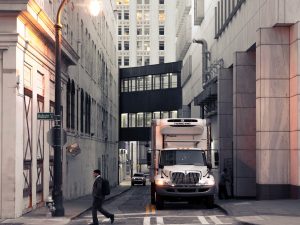The tightest trucking market in years is testing the limits of an otherwise well-conditioned U.S. economic expansion. It’s also tinder for accelerating inflation should the capacity constraints spark moves by companies to pass on those higher delivery costs.
A shortage of drivers, new regulations and solid demand are driving up rates charged by trucking companies to haul loads over the country’s more than 46,000 miles of interstate highways. Combined with higher materials prices, partly due to the Trump administration’s tariffs, rising transportation costs are putting pressure on goods producers.
“Demand is exceeding capacity in most modes of transportation by a significant amount,” Donald Broughton, managing partner of Broughton Capital, wrote in the Cass Freight Index Report. “In turn, pricing power has erupted in those modes to levels that continue to spark overall inflationary concerns in the broader economy.”
Producer-price figures from the Labor Department showed that inflation continued to build in the sector last month, with general long-distance freight trucking costs advancing 9.4 percent in June from a year earlier. That was the largest year-over-year increase in nearly a decade. The broader producer-price index was up 3.4 percent, the most since November 2011.
Enjoying our insights?
Subscribe to our newsletter to keep up with the latest industry trends and developments.
Stay InformedRising Cost
Anecdotes about rising costs are piling up. The Federal Reserve’s latest Beige Book, published in late May, cited a North Carolina trucking company that said some customers were willing to pay rates that quadrupled. In the Chicago district, “numerous contacts” said freight costs had “increased dramatically.”
The cost to haul a full truckload of finished product or materials has soared this year. Cass Information Systems’ measure of per-mile rates, excluding fuel charges, jumped 9 percent in May from a year earlier, the most in records going back 13 years.
Per-mile rates soar
Per-mile rates for dry vans, temperature-controlled trailers and flatbeds have roared above $2, according to data from Truckstop.com.
Rates are on the move because the economy is on cruise control as steady-and-solid business investment and consumer spending stretch the capacity of the nation’s freight sector. What’s more, the implementation of electronic logging devices that ensure drivers adhere to maximum-allowable hours on the road and duty time has effectively removed the ability to fudge paper logs. While that may make the roads safer, it’s nonetheless another capacity restraint.

An index of May freight shipments from Cass was the strongest since before the last recession and close to a record in data back to 1990. That helped propel a measure of expenditures on truck transportation to an all-time high.
Truck Drivers Needed
A near-record number of unfilled positions across the U.S., along with the grind and stress of a career putting in long hours behind the wheel, underscore the difficulty the trucking industry has in attracting drivers. Government figures show that while long-distance freight hauling payrolls are increasing, they’re doing so at a snail’s pace and remain below the peaks of the last two expansions.
Last year, wage gains merely matched the rate of inflation in the broader economy. With the freight-transportation sector tightening and companies growing more desperate to put people behind the wheels of big rigs, that may start to change. Historically, about 30 percent of trucking companies’ rate increases are passed through in the form of wage increases, according to Bloomberg analyst Klaskow.
“The market has been much tighter this time around and they are passing at least 50 percent to drivers now, and a smaller percentage is going to the bottom line,” Klaskow said.
(This article was first reported by Crain’s Chicago Business)
























